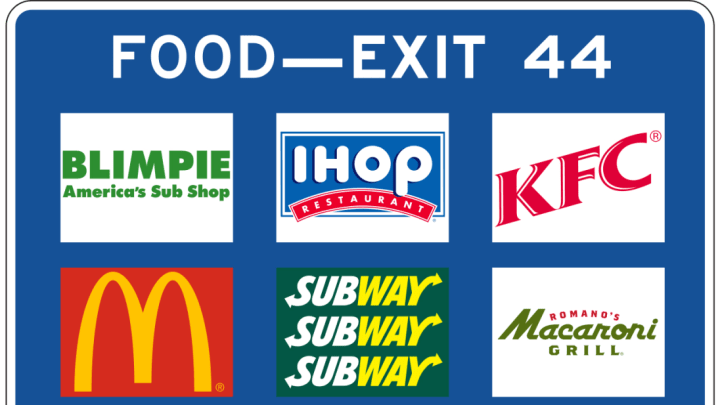How Much Do Companies Pay to Get Their Logos on Those Blue Highway Exit Signs?

IMZADI1979, Wikimedia Commons // Public Domain
When you’re driving down the highway searching desperately for a bathroom and a Big Mac, the appearance of one of those blue exit signs—the ones that advertise food, lodging, and other amenities along highway off-ramps—can seem like a miracle, alerting you to the unexpected appearance of a Taco Bell or the all-important availability of a gas station. But who or what determines which businesses get their logos on those signs?
As usual, it all comes down to money. But how much do businesses have to pay to get their names on those signs? Jalopnik tracked down the rules and regulations that govern those highway signs, and they’re more complicated than you might think.
While the regulations vary from state to state, not every business can slap its logo on what’s called Specific Services Signing. It has to be in a certain category of services, for one—food, pharmacy, gas, camping, etc. Then, there are restrictions on what those businesses have to offer to be eligible. In New Jersey, for instance, regulations require that gas and food establishments be within three miles of the highway, operate 12 to 16 hours a day, and provide public bathrooms and telephones. In Oregon, restaurants must have indoor seating for at least 20 people and serve at least two meals a day, among other qualifications [PDF].
If your business does qualify to erect an exit sign, how much it costs varies based on the location. Some states contract out their programs to private companies like Interstate Logos, which then create and maintain the signage, while other states maintain the signs themselves. In Oregon, permit fees are determined based on daily traffic estimates—heavily trafficked stretches of highway cost $605 per year, per mainline sign, while highways with less than 20,000 drivers passing per day only cost $360 per sign per year [PDF]. In Colorado, a mainline sign costs $750 per direction [PDF]. In Virginia, a single sign can cost as much as $1000 a year [PDF].
Then there’s the cost of manufacturing the logo sign itself to attach to the blue board, which can run several hundred dollars per sign. Washington State’s guidelines estimate that the smallest logo—a 2-by-1-foot sign—can cost between $84 and $530, and a 5-by-3-foot sign can cost between $330 and $530.
Typically, there can only be six logos per mainline sign (meaning the ones that come before the exit ramp), and often there are more businesses vying for signage than there are spaces for logos. In Colorado, logos are rotated in and out annually, while Washington maintains a waiting list; Arizona uses a bidding process, and Michigan [PDF] assigns priority based on the closest proximity to the highway.
But businesses wouldn’t deal with the application process if it wasn’t worth it. Waiting lists to get on the signs can be decades long, and there’s typically low turnover of businesses opting out of the programs (just 1 to 2 percent in Kentucky). Clearly, there are a lot of drivers out there just waiting to be swayed into stopping for fast food.
Have you got a Big Question you'd like us to answer? If so, let us know by emailing us at bigquestions@mentalfloss.com.